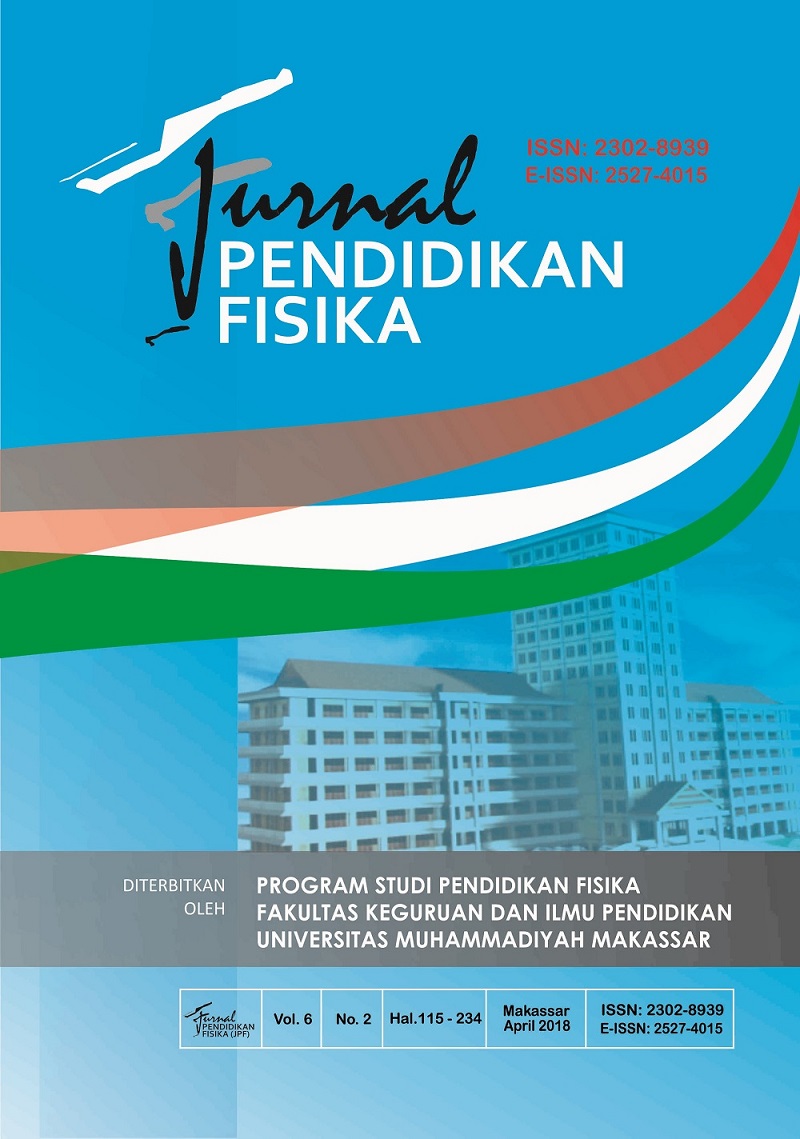Desain dan Uji Coba Multimedia Pembelajaran Fisika Interaktif Untuk Siswa Kelas XI IPA SMA Muhammadiyah 3 Makassar
DOI:
https://doi.org/10.26618/jpf.v6i2.1307Abstrak
Penelitian ini adalah penilitian pengembangan menggunakan model 4D yang diadaptasi dari model 4D Thiagarajan. Produk yang dikembangkan dalam penelitian ini adalah multimedia pembelajaran fisika interaktif. Adapun tahapan yang dilalui dalam penelitian ini adalah tahapan pendefinisian (define), perancangan (design), pengembangan (develop), dan penyeberan (desiminate). Dalam penelitian ini tahap penyebaran (desiminate) dilakukan namun tidak sampai pada melihat hasilnya hanya pada sebatas pengemasan produk. Teknik pengumpulan data melalui teknik observasi dan pembagian angket dengan alat pengumpulan data menggunakan lembar observasi, lembar validasi multimedia pembelajaran fisika interaktif, dan lembar tanggapan guru. Hasil uji coba dalam tahap pengembangan menunjukkan bahwa multimedia pembelajaran fisika interaktif valid, dengan presentase tanggapan guru sebesar 74,8% dan respon siswa terhadap multimedia pembelajaran fisika interaktif positif dengan presentase 75,1%.
Kata kunci: penelitian pengembangan, uji coba, multimedia pembelajaran fisika interaktif
This study is a development study using a 4D model adapted from the Thiagarajan 4D model. The product developed in this research is interactive physics learning multimedia. The stages in this research are defining, define, design, development, and desiminate. In this research the dissemination stage (desiminate) is done but not to see the results only on the limited product packaging. Data collection techniques through observation techniques and questionnaire distribution by means of data collection using observation sheet, interactive physics learning interactive physics sheet, and teacher response sheet. The results of experiments in the development stage showed that the interactive physics learning multimedia is valid, with the percentage of teacher responses of 74.8% and the students' response to interactive interactive physics learning multimedia with the percentage of 75.1%.
Key words: research development, testing, interactive multimedia learning physicsReferensi
Bates, A.W. (1995). Technology, Open Learning and Distance Education. London: Routledge.
Daryanto, 2010. Media Pembelajaran Perananya Sangat Penting dalam Mencapai Tujuan Pembelajaran. Yogyakarta: Gava Media.
De Diana, I. 1988. Het EDUC System: Aspecten van een methodologie, ontwikkelingsmethode en instrumentatie voor tutorieel COO. PhD Thesis, Enshede: Twente University.
Gregory, R. J. 2000. Psycological Testing: History, Principles and Aplications. Boston: Allyn and Bacon.
Hamalik, Oemar. 2002. Manajeen Pengembangan Kurikulum. Bandung: Remaja Rosdakarya.
Hamalik, oemar. 2007. Manajemen pengembangan kurikulum. Bandung; Remaja Rosdakarya.
Hamid, 2013. Upaya Peningkatan Hasil Belajar Fisika Melalui Concept Mapping Approach Pada Siswa Kelas XII IPA 3 SMA Negeri 22 Makassar. Skripsi. Tidak Ditebitkan. Makassar: Univesitas Muhammadiyah Makassar.
Hasan, 2011. Hubungan Antara Pengetahuan Dasar Matematika dan Motivasi Belajar dengan Hasil Belajar Fisika Siswa Kelas Xi IPA SMA Negeri 1 Makassar Tahun Ajaran 2010/2011. JSPF Vol. 7 No. 2. Universitas Negeri Makasaar.
Munir, 2001. Aplikasi Multimedia dalam Proses Belajar Mengajar. Mimbar Guruan XX(3). Universitas Guruan Indonesia.
Munir, 2012. Multimedia Konsep dan Aplikasi dalam Guruan. Bandung: Alfabeta
Riduwan, 2010. Metode dan Teknis Menyusun Tesis. Bandung: Alfabeta.
Sudjana, 1992. Penilaian Hasil Proses Belajar Mengajar. Bandung: PT. Remaja Rosdakarya
Sudjana, 2005. Metoda Statistika. Bandung: Tarsito.
Sutopo, Ariesto Hadi. 2003. Multimedia Interaktif dengan Flash. Graha Ilmu. Yogyakarta.
Unduhan
Diterbitkan
Terbitan
Bagian
Lisensi
Copyright:
Authors who publish with this journal agree to the following terms:
1. Authors retain copyright and grant the journal right of first publication with the work simultaneously licensed under a Creative Commons Attribution-ShareAlike 4.0 International License that allows others to share the work with an acknowledgement of the work's authorship and initial publication in this journal.
2. Authors are able to enter into separate, additional contractual arrangements for the non-exclusive distribution of the journal's published version of the work (e.g., post it to an institutional repository or publish it in a book), with an acknowledgement of its initial publication in this journal.
3. Authors are permitted and encouraged to post their work online (e.g., in institutional repositories or on their website) prior to and during the submission process, as it can lead to productive exchanges, as well as earlier and greater citation of published work.
Licence:
Authors are free to:
1. Share: Copy and redistribute the material in any medium or format
2. Adapt: Remix, transform, and build upon the material for any purpose, even commercially.
The licensor cannot revoke these freedoms as long as the authors follow the license terms, which include the following:
1. Attribution: You must give appropriate credit, provide a link to the license, and indicate if changes were made. You may do so in any reasonable manner, but not in any way that suggests the licensor endorses you or your use.
2. ShareAlike: If you remix, transform, or build upon the material, you must distribute your contributions under the same license as the original.
3. No additional restrictions: You may not apply legal terms or technological measures that legally restrict others from doing anything the license permits.
Jurnal Pendidikan Fisika is licensed under a Creative Commons Attribution-ShareAlike 4.0 International License.

